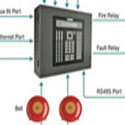Security System Technologies - Fire Alarm Systems

A fire alarm system is a set of electric/electronic devices/equipment working together to detect and alert people through visual and audio appliances when smoke/fire is present. These alarms may be activated from smoke detectors, heat detectors, water flow sensors, which are automatic or from a manual fire alarm pull station.
Addressable Fire Alarm Control Panels

Signaling Line Circuits
Addressable Fire Alarm Control Panels employ one or more Signaling Line Circuits, slang - usually referred to as loops or SLC loops - ranging between one and thirty. Depending on the protocol used, a Signaling Line Circuit can monitor and control several hundred devices.
Some protocols permit any mix of detectors and input/output modules, while other protocols have 50% of channel capacity restricted to detectors/sensors and 50% restricted to input/output modules. Each SLC polls the devices connected, which can number from a few devices to several hundred, depending on the manufacturer. Large systems may have multiple Signaling Line Circuits.

Each device on a SLC has its own address, and so the panel knows the state of each individual device connected to it. Common addressable input (initiating) devices include
• Smoke detectors
• Heat Detectors (Rate of Rise and Fixed Temperature)
• Manual call points or manual pull stations
• Notification appliances (Simplex systems with TrueAlert signals only)
• Responders
• Fire sprinkler system inputs
• Switches
• Flow control
• Pressure
• Isolate
• Standard switches
Addressable output devices are known as relays and include
• (Warning System/Bell) Relays
• Door Holder Relays
• Auxiliary (Control Function) Relays
Relays are used to control a variety of functions such as
• Switching fans on or off
• Closing/opening doors
• Activating fire suppression systems
• Activating notification appliances
• Shutting down industrial equipment
• Recalling elevators to a safe exit floor
• Activating another fire alarm panel or communicator
Conventional fire alarm control panels
A Simplex 4002 conventional FACP
Conventional panels have been around ever since electronics became small enough to make them viable. Conventional panels are used less frequently in large buildings than in the past, but are not uncommon on smaller projects such as small schools, stores, restaurants, and apartments.
A conventional Fire Alarm Control Panel employs one or more circuits, connected to sensors (initiating devices) wired in parallel. These sensors are devised to dramatically decrease the circuit resistance when the environmental influence on any sensor exceeds a predetermined threshold. In a conventional fire alarm system, the information density is limited to the number of such circuits used.
To facilitate location and control of fire within a building, the structure is subdivided into definite areas or zones. Floors of a multistory building are one type of zone boundary.
An Initiating Device Circuit connected to multiple devices within the same "zone" of protection, effectively provides 2 bits of information about the zone corollary to the state of the circuit; normal, or off normal and alarm or quiescent. The state of each Initiating Device Circuit within a zone displays at the Fire Alarm Control Panel using visible indications called Annunciators.
These Annunciators may employ a graphical representation of the Zone boundaries on a floor plan (Zone map) using textual descriptions, illuminated icons, illuminated sections, or illuminated points on the map corresponding to Initiating Circuits connected to the Fire Alarm Control Panel.


